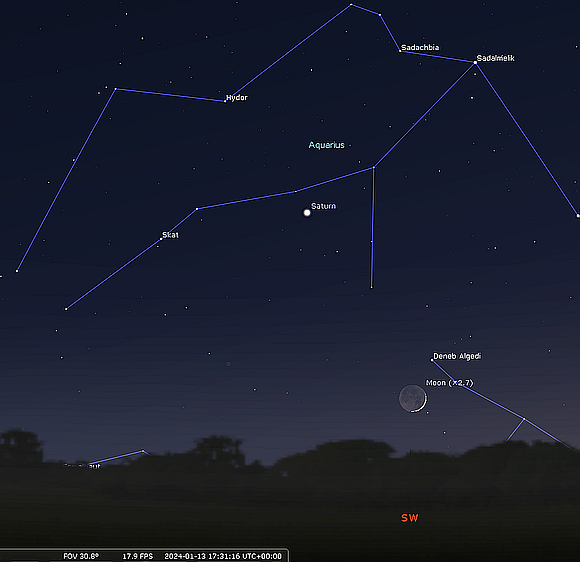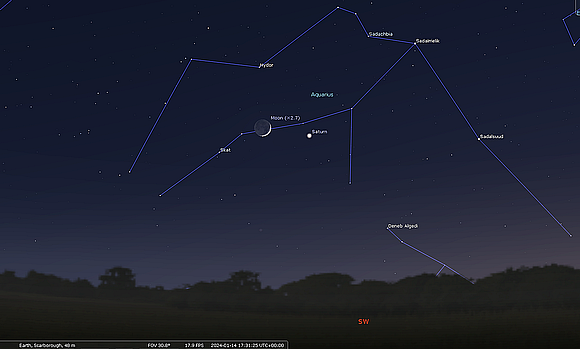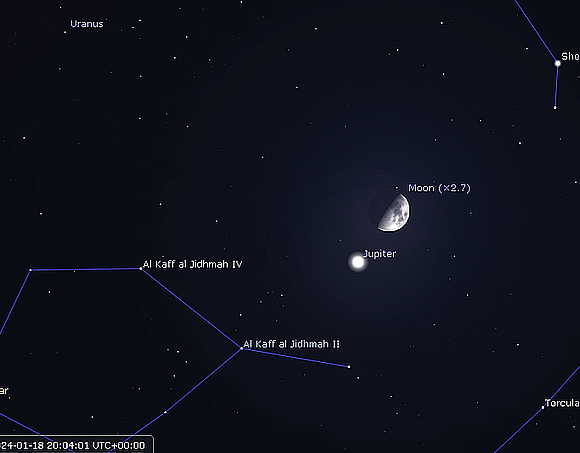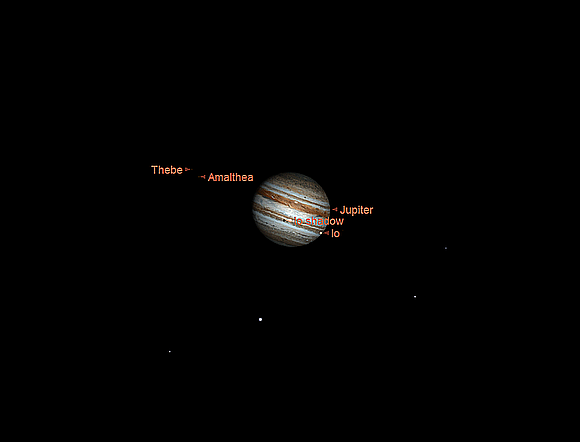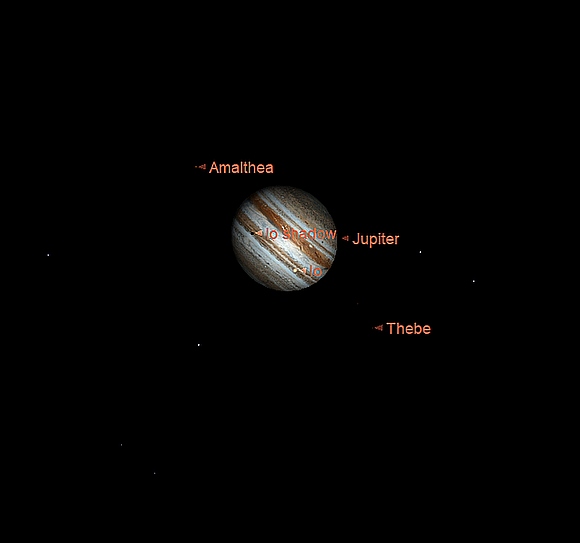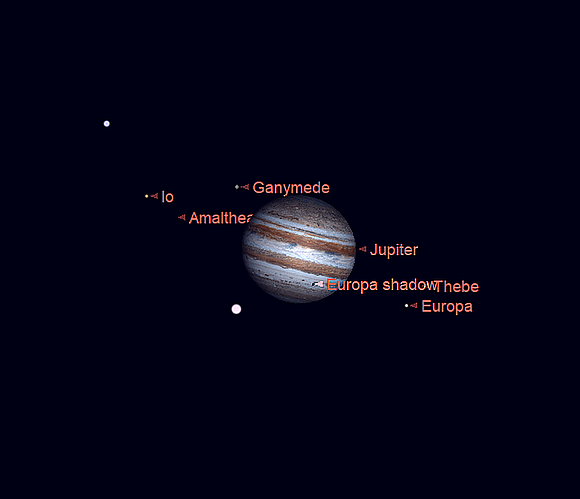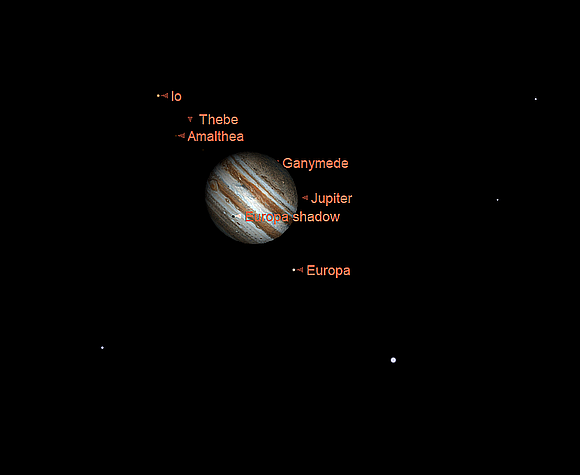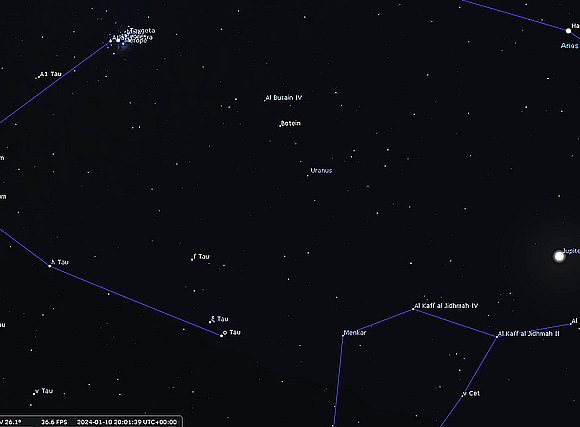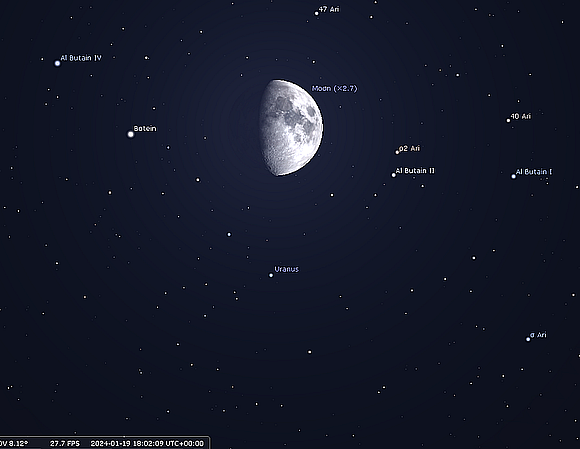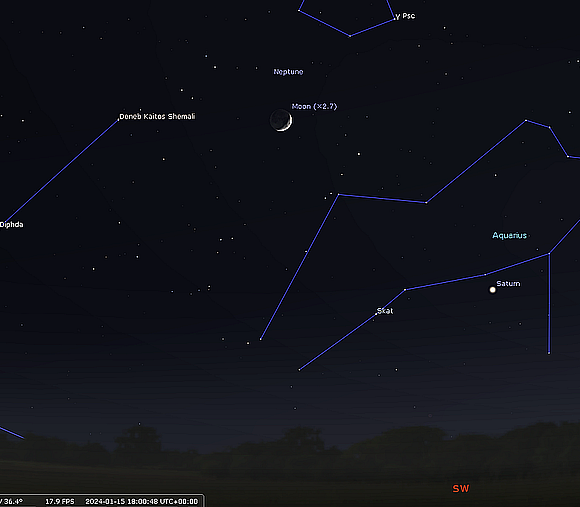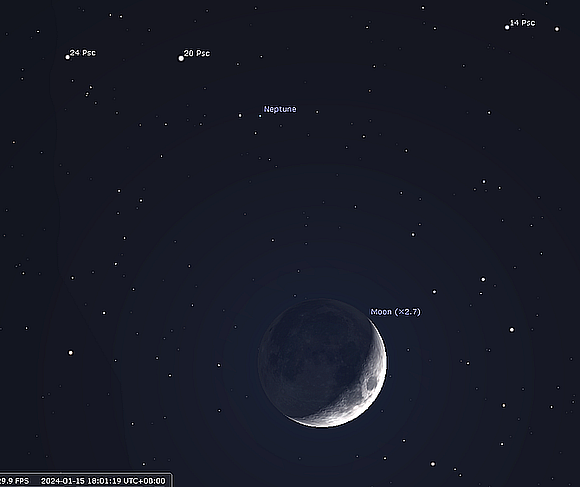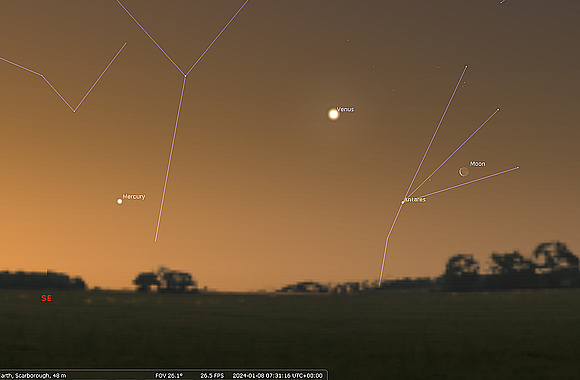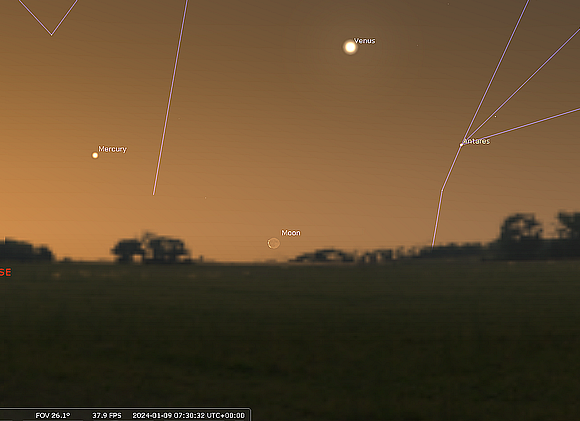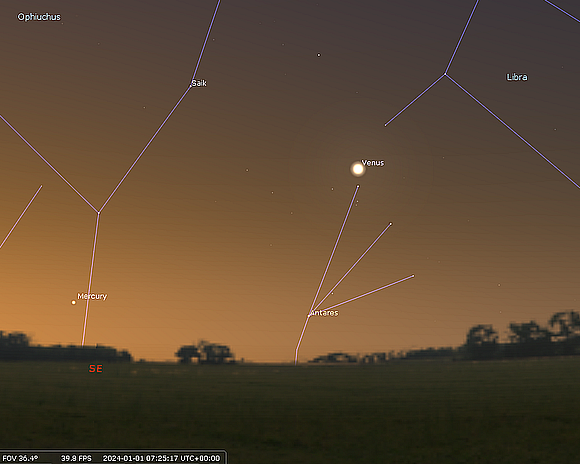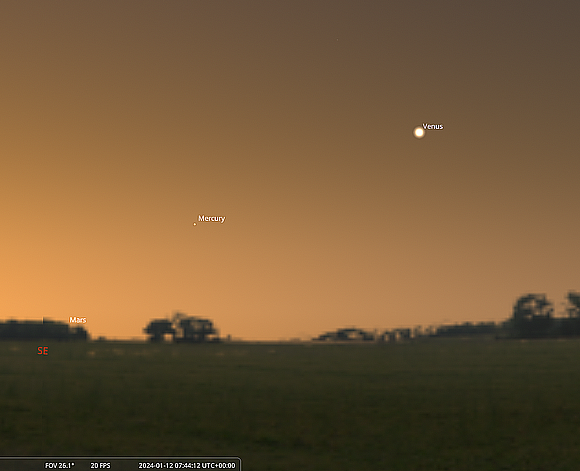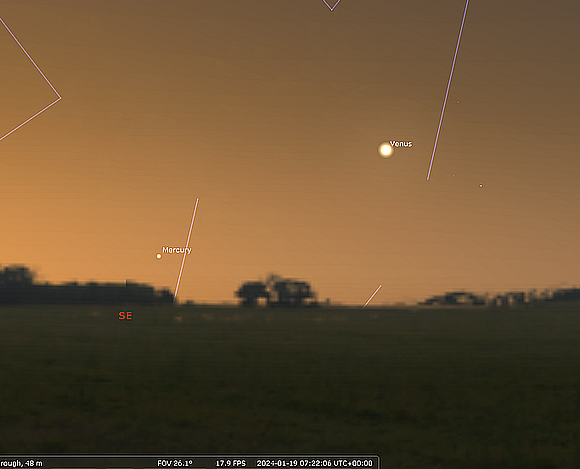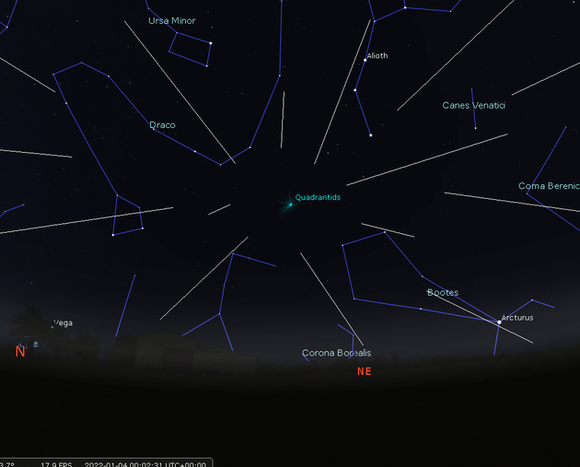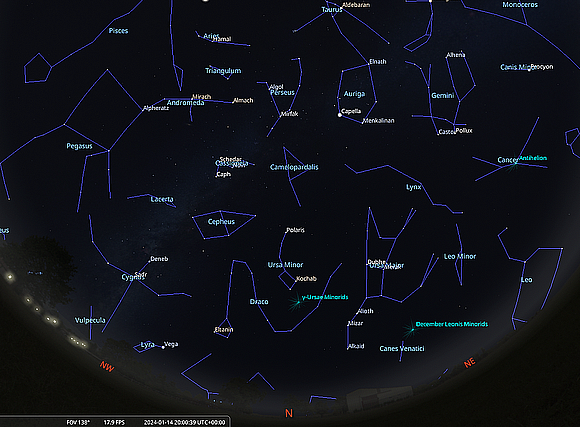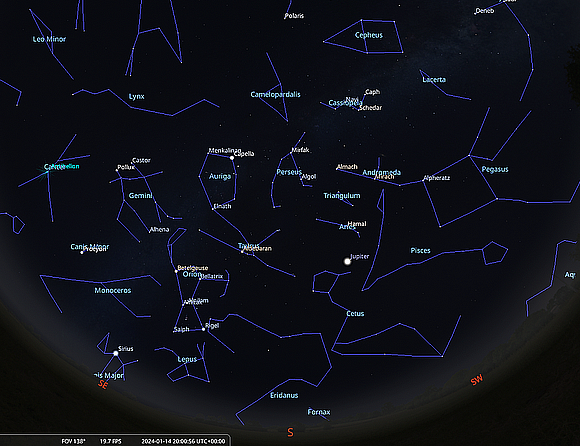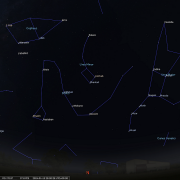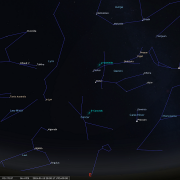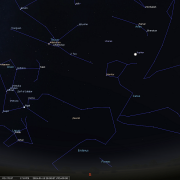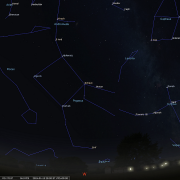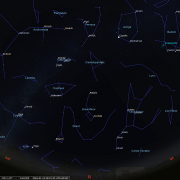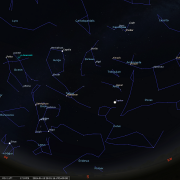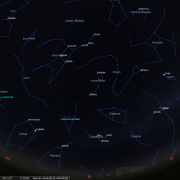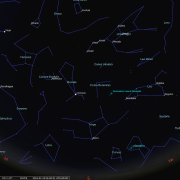In this month's Sky Notes:
Planetary Skylights - Brief
Jupiter reigns supreme in the New Year evening sky as Saturn slips to the horizon, Neptune following behind. Uranus is well placed for evening observation. Mercury has a half decent morning apparition. Dazzling Venus starts to sink back to the horizon.
 Saturn remains visible throughout January but a viable observing target for the first week or so only, and by the month's end is setting by 18:30hrs from the UK. Early January will therefore be the final opportunity to observe Saturn in a dark sky until June. You can locate Saturn low in the SW as twilights falls, a magnitude +0.8 object, conspicuous amongst the faint stars of southern Aquarius - just above the horizon.
Saturn remains visible throughout January but a viable observing target for the first week or so only, and by the month's end is setting by 18:30hrs from the UK. Early January will therefore be the final opportunity to observe Saturn in a dark sky until June. You can locate Saturn low in the SW as twilights falls, a magnitude +0.8 object, conspicuous amongst the faint stars of southern Aquarius - just above the horizon.
Given any decent 'seeing', Saturn will appear quite pleasing to the eye through the eyepiece, the rings tilted by around 10 degrees in orientation. This will continue to diminish until the next ring plane crossing event in 2025. Observing ring details will be rather more challenging for smaller instruments under 150mm (5"), with the Cassini division perhaps discernible in larger instruments with good 'seeing' present. Saturn's largest moon, Titan, will however be visible as a speck of light in nearly all instruments. As Saturn draws closer to the SW horizon the image will degrade further, so make the most of opportunities early in January should they present themselves. The crescent Moon lies below Saturn on the 13th and is in conjunction the following evening (14th) to the left of Saturn.
 At magnitude -2.4 Jupiter continues to be the most dominant planetary object in the evening sky, well placed for UK observers, especially at the start of the month. As dusk falls it is located quite high to the SSW, although by the end of the month, it is setting by 21:00hrs. A first quarter Moon lies just above Jupiter on January 18th.
At magnitude -2.4 Jupiter continues to be the most dominant planetary object in the evening sky, well placed for UK observers, especially at the start of the month. As dusk falls it is located quite high to the SSW, although by the end of the month, it is setting by 21:00hrs. A first quarter Moon lies just above Jupiter on January 18th.
Through the eyepiece Jupiter exhibits an oblate disk some 45 arc seconds in diameter flanked by the Galilean moons - visible as specks of light. The dark equatorial belts will be readily visible in instruments as small as 60mm (2.5”) aperture, with the less evident polar regions apparent in 75mm instruments. Mounted binoculars in the range of 12 x 50 and 15 X 70 should also reveal these features. Larger instruments will show the finer northern and southern temperate belts.
When orientated in our direction look for the great red spot feature, a colossal storm system, which over the last four decades appears to have diminished in size and hue intensity. The GRS can be observed in 100mm (4”) scopes but will be more obvious with 150mm (6”) instruments at medium powers. Look for the GRS on Jan 3rd, 5th,10th, 15th, 17th, 22nd, 24th and 29th between 19:00hrs and 21:00hrs.
Jupiter is flanked by the Galilean moons, seen as specks of light close by, but are planetary sized worlds. Regular observers of the Jovian system will note the 'dance' of Io, Europa, Ganymede, and Callisto around Jupiter, throwing up a different configuration each night. From time-to-time shadow transits (visible as black dots transiting the disk of Jupiter) are particularly fascinating to follow. To view these an aperture of 100mm (4") with high magnification should suffice. The moons themselves are more difficult to spot as they pass in front of Jupiter, requiring larger apertures. The most favourable evening shadow transits in January are: - Io - Jan 16th @ 18:30hrs & Jan 23rd @ 20:00hrs. Europa - Jan 17th @ 18:00hrs & Jan 24th @ 20:00hrs.
 Uranus remains well placed for observation in the evening sky located roughly between Jupiter and the Pleiades star cluster. With a magnitude of +5.8 Uranus is technically visible to the naked eye, however very dark, transparent skies and knowledge of the exact location are required to achieve this. An aperture of 75-80mm (3") at high power can reveal the tiny 3.5-degree disk, soft green/grey in hue, whilst instruments above 150mm (6") will clearly show it.
Uranus remains well placed for observation in the evening sky located roughly between Jupiter and the Pleiades star cluster. With a magnitude of +5.8 Uranus is technically visible to the naked eye, however very dark, transparent skies and knowledge of the exact location are required to achieve this. An aperture of 75-80mm (3") at high power can reveal the tiny 3.5-degree disk, soft green/grey in hue, whilst instruments above 150mm (6") will clearly show it.
Uranus currently resides in the lower reaches of Aries, not far above the 'head' of Cetus, but close to the Taurus/Aries border, culminating some 50 degrees above the south horizon as dusk falls. There are no obvious stars nearby - the 4th magnitude Delta Ari (Botein) sits just over 2 degrees above Uranus, 53 and 54 Ari are also nearby, but even fainter. The waxing quarter Moon sits a few degrees above Uranus on January 19th around 18:00hrs GMT.
 Remote Neptune remains on show for telescopic observation throughout January evenings. The outermost planet resides approximately 15 degrees east of Saturn, below the faint loop of stars marking the western fish of Pisces - in particular lambda Piscium (mag 4.5). The nearest 'bright' star is 5th magnitude 20 Piscium 30 arcminutes to the right of Neptune. Neptune itself appears as a magnitude +7.9 object with a minute 2.4 arc-second disk seen through the eyepiece.
Remote Neptune remains on show for telescopic observation throughout January evenings. The outermost planet resides approximately 15 degrees east of Saturn, below the faint loop of stars marking the western fish of Pisces - in particular lambda Piscium (mag 4.5). The nearest 'bright' star is 5th magnitude 20 Piscium 30 arcminutes to the right of Neptune. Neptune itself appears as a magnitude +7.9 object with a minute 2.4 arc-second disk seen through the eyepiece.
Unless 'seeing' is steady the blue/grey disk is not obvious, an aperture of 150mm (6”) and medium/high magnification is required to clearly define it. Neptune can be spotted as a speck in 10x50 binoculars (if you know exactly where to look). On January 15th a crescent Moon lies just a few degrees below Neptune. By the month’s end Neptune is setting by 20:00hrs GMT from the UK.
 Venus continues to be a brilliant presence in the dawn sky throughout January, rising in the east by 05:30hrs GMT and an hour later by the month's end. Its fine morning apparition is ending, dropping from over 30 degrees elevation to less than 6 degrees by start of Civil twilight at the end of January. Nevertheless, at magnitude -4.1 Venus continues to attract the eye. Venus can appear over dazzling through the eyepiece, so, if possible, wait until skies begin to lighten to better discern the phase, some 75% gibbous. A slim waning crescent Moon sits below/right of Venus on Jan 8th below/left the following morning, view from 07:15 hrs. Note Antares and Mercury below right and left - respectively!
Venus continues to be a brilliant presence in the dawn sky throughout January, rising in the east by 05:30hrs GMT and an hour later by the month's end. Its fine morning apparition is ending, dropping from over 30 degrees elevation to less than 6 degrees by start of Civil twilight at the end of January. Nevertheless, at magnitude -4.1 Venus continues to attract the eye. Venus can appear over dazzling through the eyepiece, so, if possible, wait until skies begin to lighten to better discern the phase, some 75% gibbous. A slim waning crescent Moon sits below/right of Venus on Jan 8th below/left the following morning, view from 07:15 hrs. Note Antares and Mercury below right and left - respectively!
 Mercury has a respectable morning showing in the dawn sky during the first half of January. Look for this elusive planet low in the SE from 07:15hrs during the first week in January just a few degrees above the horizon, a good clear aspect is essential for this. Brilliant Venus lies upper right of Mercury, which itself shines at +0.6 as the New Year starts, brightening to -0.1 by the end of first week. Around the time of greatest western elongation on Jan 12th, Mercury will reach 6 degrees in altitude and -0.2 in magnitude. Thereafter Mercury will slip back toward the horizon. View 35 mins before sunrise.
Mercury has a respectable morning showing in the dawn sky during the first half of January. Look for this elusive planet low in the SE from 07:15hrs during the first week in January just a few degrees above the horizon, a good clear aspect is essential for this. Brilliant Venus lies upper right of Mercury, which itself shines at +0.6 as the New Year starts, brightening to -0.1 by the end of first week. Around the time of greatest western elongation on Jan 12th, Mercury will reach 6 degrees in altitude and -0.2 in magnitude. Thereafter Mercury will slip back toward the horizon. View 35 mins before sunrise.
January Meteors
Meteor activity remains high as the New Year offers up one of the big three meteor showers - the Quadrantids, with a ZHR peak rate topping 100. The shower is named after the now defunct constellation of Quadrans Muralis, removed from sky charts in 1922, but used to lie at the junction between Hercules, Bootes and Ursa Major. The Quadrantids are the least observed of the major meteor showers, factors such as timing, weather, and a short peak duration of just a few hours at play here. The Quadrantids 'meteoroid' stream is constantly evolving, with the orbit appearing to oscillate up and down relative to the plane of the Ecliptic. During the early centuries AD, the shower stream was encountered in July as an Aquarid radiant! The shower was then missing for over a thousand years before reappearing in the 1700s again. The shower will again be 'lost' in another 300-400 years.
Minor Quadrantid activity ranges from late December until Jan 12th, but rapidly diminishes after Jan 6th to sporadic levels. During the evening of January 3rd, the shower radiant is positioned low to the North and few meteors will be seen. The short-lived peak occurs in the early morning hours of the 4th, by which time the radiant will be positioned almost 50 degrees above the ENE horizon. A last quarter Moon located in the SE will interfere somewhat, but not as much as a first Qtr Moon would be due to the larger expanse of dark lunar seas.
Peak Zenith Hourly Rates can exceed 100 under ideal conditions and circumstances, but don't expect to see anything like that number. The actual peak is expected 12:45hrs (daylight) on the 4th. Should skies be clear in the early morning hours an observer should expect to witness a respectable 20-35 meteors per hour this year. Quadrantids can be bright, sometimes blue, or green in hue. You will not require any additional optical assistance; the naked eye is quite sufficient, check the forecast, wrap up warm, find a decent location with good viewing aspects all around and enjoy.
January Night Sky
As darkness falls the southern and western aspect of the night sky is still dominated by seasonal autumnal constellations. The great square of Pegasus occupies much of the SSW, the orientation of the winged horse tilted as the winged steed rears up as it topples into the west. Below Pegasus lie the less conspicuous constellations of Pisces and Cetus the whale (the Kraken in mythology), which continues to churn along the South horizon below Pisces. Use the front two stars in the square to locate the 'Krakens' brightest star Diphda. Stradling the SW horizon Aquarius departs by mid - evening around mid-month.
We may be in the midst of Winter, however early evening in the NW offers up more of a 'summer' vibe with a number of constellations associated with July and August still visible. Notable amongst these is Cygnus, the stars of which hang crucifix form below its chief star Deneb above the WNW horizon. Lower still, look for the sparkling steely blue presence of Vega, the most conspicuous of the summer triangle stars. The third member of the summer trio; Altair in Aquila, may be glimpsed before 18:00hrs setting due west by midmonth. Deneb and Vega will continue to arc low above the north horizon over the coming winter months.
Viewing North during the evening note the familiar ‘saucepan’ asterism of the Plough, part of Ursa Major, balancing on its handle above the NNE horizon. The rear 'bowl' stars of Plough; Dubhe and Merak, can be utilised to track down the pole star; Polaris due North. The 'North star' resides at the tail end of Ursa Minor - the Lesser Bear. The Celestial dragon – Draco winds its way between the two bears towards the NNW where the head of the beast is marked by an irregular quadrilateral of stars not far from Vega. Overhead, the zenith position is occupied in turn by the distinctive ‘W’ pattern of Queen Cassiopeia, followed later by Perseus (the outline of which resemble a distorted figure Pi symbol) and then the stars of Auriga the charioteer, highlighted by brilliant Capella, which lies just shy of the zenith at 22:00hrs. The faint stars of Lynx slink after the charioteer.
It is however to the South and East where the observer's gaze is treated to an array of imposing constellations rich in mythology and observational interest, dripping in brilliant stars. Leading this wondrous stellar cavalcade is the constellation of Taurus the Bull, in which lie the two open star clusters of the Hyades and Pleiades. Prominent ruddy Aldebaran - 'the eye of the bull’ is the most conspicuous stellar presence in the Hyades, a ‘V’ or arrowhead arrangement of stars, although at 67 light years, Aldebaran is not a genuine member, a foreground object lying at half the distance of true Hyades member stars.
Further west of the Hyades, the Pleiades star cluster (Seven Sisters) is truly a beautiful sight in binoculars or low power eyepiece. It is one of the most youthful clusters by stellar standards. Keen sighted observers can make out more than seven stars with the naked eye, although most people see five or six. Binoculars, or very low telescopic magnifications reveal dozens of stars, and the entire cluster contains well over 300 members approximately 410 light years away.
By late evening, or viewed later in the month, the constellation of Orion - the mighty hunter, stands proud at the heart of this glittering tableau ranged across the southern aspect. The main outline of the hunter is quite distinct; three stars in a sloping line set amid a larger rectangle bounded by 4 others. Two of these stars, in opposing corners are genuine super luminaries. Rigel illuminates the bottom right of the rectangle, a B7 class blue/white star at least 60 thousand times more luminous than our Sun.
The top left corner is marked by the orange hue of Betelgeuse, a red super-giant star already ballooned to gargantuan proportions, over 400 million miles in diameter and with one foot in the stellar grave. Betelgeuse is likely to go supernova, perhaps within the next 10-20 thousand years, perhaps sooner, the recent temporary fading, and then brightening of this star, maybe an indication of initial behaviour towards this cataclysmic fate. Rigel is also massive enough to follow on a similar path to ultimate destruction, a few tens of millions of years in the future, a short time by stellar standards.
Situated beneath the three stars marking Orion’s belt is one of the great show piece objects in the night sky, the Orion nebula, the 2nd closest region of stellar birth at around 1300 light years. The Nebula consists of a huge cloud of gas and dust in which new stars are “born”. Seen clearly as a misty smudge through binoculars, telescopically the nebula is quite breathtaking in the right instrument, a swirl of nebulous cloud at the heart of which reside a trapezoid-shaped asterism from which the cluster gets its name, the Trapezium, the four “bully boys” of this stellar crèche. The brightest members are found within 1.5 light years of each other and have estimated solar masses of between 15 and 30 times our Sun. These young OB stars are luminous X-ray sources and are also responsible for much of the illumination of the surrounding nebula. It is thought the Trapezium stars are little more than 300,000 years old. The stars are easily seen through the eyepiece of most telescopes.
Upper left of Orion, stand the Twins of Gemini, marked by the two conspicuous stars, Castor, and Pollux. Castor, the most northerly of the pair, is slightly fainter than twin brother Pollux which shines with a pale amber lustre. Although Castor appears solitary, it is a multiple system comprising 6 stars of which the brightest two components may be separated with modest scopes, given stable atmospheric conditions.
The two hunting dogs of Orion, Canis Major, and Canis Minor, dutifully follow their master across the heavens. The belt stars of Orion point down in the general direction of Canis Major and the most prominent of all night stars, sparkling Sirius, seen low to the SE. Some distance above and left, solitary Procyon, in the lesser dog of Canis Minor, is yet another highly conspicuous winter jewel, the prominence of both primarily due to proximity; 8.6 and 11 light years respectively.
The dog’s quarry, the timid celestial hare of Lepus, may be traced crouching below Orion just above the southern horizon. Look for the faint glow of the winter Milky Way which passes down to the left of Orion, separating the two dogs on opposing banks. A few of the faint stars set amidst this milky haze comprise the heavenly unicorn of Monoceros an inconspicuous constellation, but full of deep sky wonders. More on this next month. To the lower right of Orion, the waters of the river Eridanus rise next to Rigel marked by the star Cursa (beta eri) before meandering along above the SE horizon. The river then drops down through the horizon and continues well into the southern hemisphere sky ending at the brilliant star Achernar far to south. Not surprisingly Eridanus is the longest (though not largest by area) constellation in the entire heavens.
Finally, by the month’s end the first celestial shoots of Spring are already sprouting from the eastern horizon making inroads into the late evening sky. The faint stars of Cancer scuttle after Gemini and mark the border of seasonal change from Winter to Spring. Leo the lion follows, identified by the ‘Sickle’ asterism at the foot of which shines bright Regulus. The faint, but distinctive head of Hydra sits below Procyon, the rest of the snake not entirely visible until well after midnight.
But now, we have the glorious winter sky to explore. Chose your instrument; binoculars, telescope or even the naked eye, wrap up well and enjoy the free vista.
January 2024 Sky Charts
Additional Image Credits:
- Planets and Comets where not otherwise mentioned: NASA
- Sky Charts: Stellarium Software and Starry Night Pro Plus 8
- Log in to post comments

